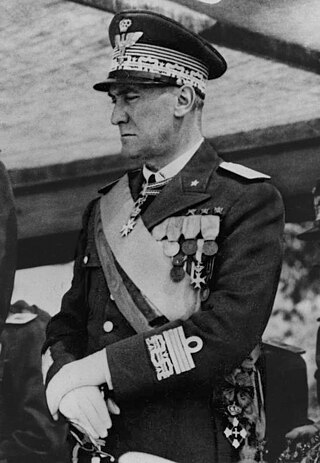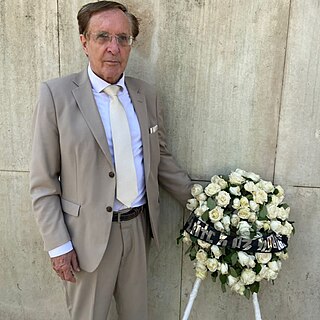
Italian East Africa was an Italian colony in the Horn of Africa. It was formed in 1936 after the Second Italo-Ethiopian War through the merger of Italian Somalia, Italian Eritrea, and the newly occupied Ethiopian Empire.

Haile Selassie I was Emperor of Ethiopia from 1930 to 1974. He rose to power as Regent Plenipotentiary of Ethiopia (Enderase) for Empress Zewditu from 1916 until 1930. Haile Selassie is widely considered a defining figure in modern Ethiopian history, and the major figure of Rastafari, a religious movement in Jamaica that emerged shortly after he became emperor in the 1930s. Before he rose to power he defeated Ras Gugsa Welle Bitul of Begemder at the Battle of Anchem in 1928. He was a member of the Solomonic dynasty, which claims to trace lineage to Emperor Menelik I, believed to be the son of King Solomon and Makeda, the Queen of Sheba.

Rodolfo Graziani, 1st Marquis of Neghelli, was a prominent Italian military officer in the Kingdom of Italy's Royal Army, primarily noted for his campaigns in Africa before and during World War II. A dedicated fascist and prominent member of the National Fascist Party, he was a key figure in the Italian military during the reign of Victor Emmanuel III.

Dušan Džamonja was a Yugoslav sculptor of Serbian ancestry.

The Second Italo-Ethiopian War, also referred to as the Second Italo-Abyssinian War, was a war of aggression which was fought between Italy and Ethiopia from October 1935 to February 1937. In Ethiopia it is often referred to simply as the Italian Invasion, and in Italy as the Ethiopian War. It is seen as an example of the expansionist policy that characterized the Axis powers and the ineffectiveness of the League of Nations before the outbreak of the Second World War.

RasMakonnen Wolde Mikael Wolde Melekot, or simply Ras Makonnen, also known as Abba Qagnew, was an Ethiopian royal from Shewa, a military leader, the governor of Harar, and the father of future Emperor Haile Selassie. Described by Nikolai Gumilev as “one of the greatest leaders of Abyssinia”, he served in the First Italo-Ethiopian War, playing a key role at the Battle of Adwa.

Prince Makonnen Haile Selassie, Duke of Harar was the second son, and second-youngest child, of Emperor Haile Selassie of Ethiopia and Empress Menen Asfaw. He was made Mesfin of Harar upon the coronation of his parents in 1930.

Debre Libanos is an Ethiopian Orthodox Tewahedo monastery, lying northwest of Addis Ababa in the North Shewa Zone of the Oromia Region. It was founded in 1284 by Saint Tekle Haymanot as Debre Atsbo and was renamed as Debre Libanos in the 15th century. He meditated in a cave above the current monastery for 29 years. The monastery's chief abbot, called the Ichege, was the second most powerful official in the Ethiopian Church after the Abuna.

Antun Augustinčić was a Croatian sculptor active in Yugoslavia and the United States. Along with Ivan Meštrović and Frano Kršinić, he is considered one of the three most important Croatian sculptors of the 20th century. His most notable sculptures include the Peace monument which stands in front of the United Nations building in New York City, the Miner statue in front of the International Labour Organization headquarters in Geneva, and the sculpture of Yugoslav president Josip Broz Tito, present in several copies throughout former Yugoslavia.
Articles related to Ethiopia include:

Meskel Square is a public square in the city of Addis Ababa, Ethiopia. It is often a site for public gatherings or for demonstrations and festivals, notably, the Meskel Festival from which it takes its name.

This is a survey of the postage stamps and postal history of Ethiopia. Long an independent state in Africa, messages were originally carried by couriers called méléktegnas, who held the letters attached to a stick.

Yekatit 12, also known in Italy as the Addis Ababa massacre, is a date in the Ge'ez calendar which refers to the massacre and imprisonment of Ethiopians by the Italian occupation forces following an attempted assassination of Marshal Rodolfo Graziani, Marquis of Negele, Viceroy of Italian East Africa, on 19 February 1937. Graziani had led the Italian forces to victory over the Ethiopians in the Second Italian invasion of Ethiopia and was supreme governor of Italian East Africa. This has been described as the worst massacre in Ethiopian history.

Italians of Ethiopia are Ethiopian-born citizens who are fully or partially of Italian descent, whose ancestors were Italians who emigrated to Ethiopia starting in the 19th century during the Italian diaspora, or Italian-born people in Ethiopia.

Italian Ethiopia, also known as the Italian Empire of Ethiopia, was the territory of the Ethiopian Empire which was occupied by Italy for approximately five years. Italian Ethiopia was not an administrative entity, but the formal name of the former territory of the Ethiopian Empire which now constituted the Governorates of Amhara, Harar, Galla-Sidamo, and Scioa after the establishment of Italian East Africa.

Arada is a district of Addis Ababa, Ethiopia. Arada got its name from the Oromo "Ardaa Gabaa," meaning "Market Venue." "Ardaa" is a term the Oromo commonly use for places where folks from different directions gather. Initially, they also called it "Birbirsa Gooroo". Over time, the name evolved to signify an urban and modern life style. As of 2011 Arada's population was of 226,000. Arada is one of 10 districts of Addis Ababa, the capital of Ethiopia. Arada is a center of culture and education, with a great number of schools, cultural establishments and annual cultural events. Arada is one of the oldest parts of Addis Ababa and early history is most apparent. Its narrow, sloping streets are dotted with beautiful old one- and two-storey buildings variously adorned with verandas, pillars, bay windows and other decorations in accordance with Indian, Middle-Eastern and European styles. Despite that, there are newer areas. The district's heart is Piazza, a bustling commercial area centered on De Gaulle Square; the imposing city hall, the seat of the city government, built in 1965, and the octagonal neoclassical St Georges Cathedral, built to commemorate Emperor Menelik's defeat of the Italians in the battle of Adwa in 1896 and named after Ethiopia's patron saint Its bustling streets are dotted with stores and boutiques offering European clothing, jewelry, and a variety of other things at relatively greater rates than in other sections of the city.

The monument to the Lion of Judah is a statue of the Lion of Judah, a symbol of Ethiopian Emperors and Ethiopia, and is located in Addis Ababa.
Alem Bekagn, or 'Kerchele Prison', was a central prison in Ethiopia until 2004. Located in Addis Ababa, the prison possibly existed as early as 1923, under the reign of Empress Zewditu, but became notorious after Second Italo-Ethiopian War as the site where Ethiopian intellectuals were detained and killed by Italian Fascists in the Yekatit 12 massacre. After the restoration of Emperor Haile Selassie, the prison remained in use to house Eritrean nationalists and those involved in the Woyane rebellion. Under the Communist Derg regime that followed, the prison was the site of another mass killing, the Massacre of the Sixty, and of the torture and execution of rival groups in the Red Terror. The prison remained a site of human rights abuses until the Ethiopian People’s Revolutionary Democratic Front entered Addis Ababa on 28 May 1991, after which it became a normal prison. The prison was closed in 2004 and demolished in 2007 to allow the construction of the headquarters of the African Union.

Ethiopia–Yugoslavia relations were historical foreign relations between Ethiopia and now split-up Socialist Federal Republic of Yugoslavia. Both countries were among founding members of the Non-Aligned Movement. The first contacts between the two countries were established at the United Nations in 1947 where Yugoslavia supported Ethiopian claims on Eritrea while Ethiopia supported Yugoslav claims over the Free Territory of Trieste. After the 1948, Tito-Stalin split Yugoslavia turned towards the non-bloc countries and two countries opened their embassies in 1955. The formal diplomatic relations were established already in 1952. Emperor Haile Selassie was the first African head of state in official visit to Yugoslavia in 1954.

Ian Leslie Campbell is a British historian specialising in Ethiopia with a focus on the Italian occupation of Ethiopia. During his career, he worked together with Ethiopianist Richard Pankhurst.


















